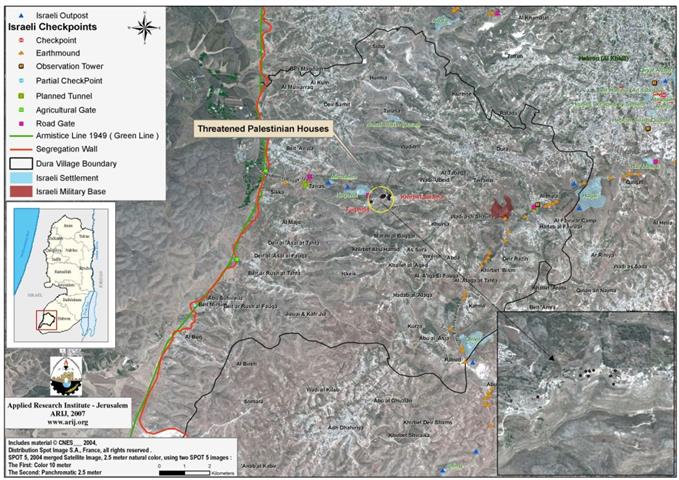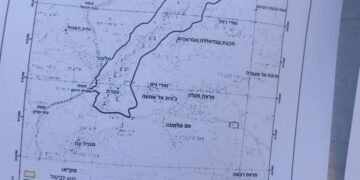Glance
House demolition has been one systematic policy of the Israeli Army, which began with the occupation of the West Bank and the Gaza Strip in 1967. The demolition campaigns started to take a turn for the worse in 2002 when Israel began construction of the Segregation Wall. Thousands of Palestinian houses have been demolished by the Israeli Army either for being unlicensed, or due to their location close to the path of the Segregation Wall.
Warnings to 'Cease Construction' in the Villages of Fuqeiqis and Khirbet Salama
On May 16, 2007, the Israeli authorities handed out the residents of Fuqeiqis and the nearby Khirbet Salama in the Hebron governorate, nine military warnings to stop the construction of new buildings and demolish what had already been constructed. Residents who received the military warnings are: Kamel Mohammad Hassan, Walled Khalil Hassan, Hamza Mohammad Ali Ishmael, Muntaha Ahmad Ishmael Al 'Arjan, Ali Musa Ishmael, Abu Falah Ahmad Salem, Majed Mahmud 'Abed Alhady Abu Sharar, Hussein Abed Al Qadder Al Darabe' and Fayez Muhammad Al Sweaty. See Table 1 for more Details.
Table 1: Details of Israeli Military Warnings to Residents of Fuqeiqis and Khirbet Salama
| No |
Owner's Name |
Type of structure |
Area in meters square |
Location |
| 1 |
Kamel Mohammad Hassan |
Home & Store |
150 / N/A |
Khirbet Salama |
| 2 |
Walled Khalil Hassan |
Home |
90 |
Khirbet Salama |
| 3 |
Hamza Mohammad Ali Ishmael |
Home |
120 |
Khirbet Salama |
| 4 |
Muntaha Ahmad Ishmael Al 'Arjan |
Home |
80 |
Khirbet Salama |
| 5 |
Ali Musa Ishmael |
Home
|
100 |
Khirbet Salama |
| 6 |
Abu Falah Ahmad Salem |
Home |
60 |
Khirbet Salama |
| 7 |
Majed Mahmud 'Abed Alhady Abu Sharar |
Home |
100 |
Fuqeiqis |
| 8 |
Hussein Abed Al Qadder Al Darabe' |
Home & Agricultural reservoir |
90 / N/A |
Khirbet Salama |
| 9 |
Fayez Muhammad Al Sweaty |
Home |
50 |
Khirbet Salama |
Source: Dura Village Council 2007
Map 1: Threatened Palestinian Houses
Palestinian owners were given a period of 34 days from the date the military warnings were issued to appeal against the demolition notices. The reason stated in the military warnings is that the structures were built in Area C (where Israel has complete control, according to the Oslo II Interim Agreement in September 1995) and without acquiring permits from the Israeli civil administration of Beit El in Ramallah. The procedure measures set by the Israeli Civil Administration (ICA) to acquire building permits is extremely difficult and almost impossible. In a report issued by BTselem, The Israeli information Center for Human Rights in the Occupied Territory listed the documents needed to get a building permit.
-
Prove of land ownership, even though Israel terminated all land registration process after the 1967 war.
-
Present proof of having no debts or any unresolved issues with the Israeli Authorities.
-
Appear before an information committee, which will not approve any plan if the following terms are not fulfilled:
1. In case the land where the structure will take place is not within village boundary (the boundary is only known to the Israeli Army) .
2. If the location of the structure to be is near an existing or proposed highway (plans of which are not given to applicants).
3. If the location of the structure to be is near or on proclaimed government or army lands.
Upon such requirements, Palestinian residents were forced to build without a license as their need to expand is growing.
More than that, it is not to the Israeli Army to stop any Palestinian from building a residential house unless the selected location constitute a security problem for the Army and the latter has to prove that beyond doubt. However, the Israeli Army, as an occupation does not abide by the international law and manipulate the laws to its advantage and to the settlers' needs.
Systematic Belligerency
Over the years, the Israeli occupation practiced all kinds of belligerency against the entire Palestinian people. Fuqeiqis village and Khirbet Salama have been put through a non-stop regime of Israeli aggression. The following is a partial enumeration of the Israeli violations:
-
October 10, 1990 Israeli bulldozers entered Fuqeiqis and demolished the house of Samih Al 'Awawda, under the pretext that his home is not licensed.
-
October 26, 2000 Israeli forces ruined wide areas of Palestinian land belong to the village of Fuqeiqis, and set up a number of mobile houses at the location as a step toward the expansion of the Negohot settlement.
-
August 8, 2001 Israeli soldiers stormed the Fuqeiqis village and placed more than six caravans on Fuqeiqis land to be annexed to Negohot settlement. (Israeli bulldozers demolished the house of 'Ayed Mahmoud 'Abed El Hadi Abu Sharar.
-
December 8, 2003 in Fuqeiqis, under the pretext of building without a permit.
-
July 7, 2004 A group of Israeli settlers constructed a new outpost to link Negohot settlement with Mizpe Lahaf outpost over 150 dunums of lands belong to Fuqeiqis village, located 300 meters to the west of Negohot settlement. As a result, 500 dunums of land owned by Al Sewiya family were lost to the settlers.
-
April 7, 2005, the Israeli Army issued a military order to confiscate 70 dunums of lands cultivated with olives and vine trees in Fuqeiqis in order to expand the nearby Negohot settlement. These lands are the property of Basim Nasr, Yousef, and 'Ali Mahmoud Nasr.
-
March 2007, Settlers from Negohot settlement (southwest of the city of Hebron) attacked several Palestinian houses in Khirbet Salama located near the settlement, and caused severe damages to the properties.
Fuqeiqis and Khirbet Salama: Location & Population
Fuqeiqis is a small, agricultural Palestinian village, located some 11 km southwest of Hebron city of and has a total population of 320 inhabitants (PCBS 2006). It is located within Dura town cluster (148,140 dunums), out of which, 21 dunums belong to Fuqeiqis residents.
Khirbet Salama has a population of 336 residents (PCBS 2006). It lies 10 km to the southwest of Hebron city. It is also part of Dura town cluster. The urban area of the village area exceeds 126 dunums, (0.1 % of the area of the total cluster).
The Segregation Wall within the Dura Villages Cluster
The route of the Segregation Wall in the West Bank has been subjected to several changes and the Israeli Army has not yet decided conclusively on its path. The Israeli Army released the last update of the Segregation Wall route in April 2006 on the website of the Israeli ministry of defense.
The Dura town cluster is one of the locations in the West Bank, which suffered from the construction of the Segregation Wall. The Israeli army announced the confiscation and separation of more than 2,761 dunums from the lands belonging to Palestinian villages located within the Dura town cluster. The wall runs 15.5 km across Dura's cluster lands of which, 12.5 km completed and the remaining 3 km are in going under construction phase to be completed by the end of this year. Once completed, the Segregation Wall stands to isolates nearly 2% of the cluster's lands between the Segregation Wall and the 1949 Armistice line (Green Line).
Conclusion
The Israeli demolition policy of Palestinian civilian houses is very widely perceived to be an act of collective punishment that breaches UN laws and Geneva conventions, specifically article 53 of 1949 to which Israel is a High Contracting Party states: 'Any destruction by the occupying power of real or personal property belonging individually or collectively to private person, or to the State, or to other public authorities, or to social or co-operative organizations, is prohibited, except where such destruction is rendered absolutely necessary by military operations.' The Israeli Army has manipulated the international law to inflict punishment on the Palestinians collectively; knowing that what it does will go with impunity.
Prepared by
The Applied Research Institute – Jerusalem
ARIJ














